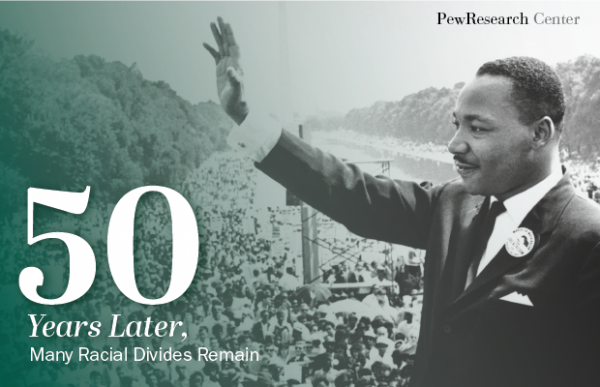On August 28, 1963, one of the largest political rallies in U.S. history gathered around the Washington Monument, advocating the civil and economic rights of African Americans: the March on Washington. Today marks the 50th anniversary of the March, the day when Dr. Martin Luther King, Jr., delivered the words we’ll never forget: “I have a dream.” Five decades later we commemorate the March and examine how much, if at all, racial equality in the U.S. has progressed since that day in 1963.
Relive the March on Washington through the Web
To allow us to relive the March, Google sponsored the creation of an interactive website for the National Park Foundation. Developed by Organic and Unit9, the site plays an original recording of Dr. King’s speech accompanied by photographs from the March. Once you enter the site, scrolling vertically passes you through the text of King’s speech and complementary pictures. You can even click the pictures to enlarge them. Additionally you can filter the pictures by photographer, location, time taken, subject, and commentary.
The site also engages users through a crowd-sourced collection of voice recordings. On the site, you can record yourself reciting Dr. King’s speech and play back others’ recordings from all over the world. Check it out here.
How Far Have We Come?
Since the March on Washington, how far have we come toward racial equality? The Pew Research Center recently released a report comparing how Americans perceive racial disparities dividing the U.S vs. how hard economic data define those disparities. Pew found that only 45% of Americans feel that the U.S. has made substantial progress toward racial equality, and 49% feel that there is a lot more to be done when it comes to moving the country toward racial equality. Despite the perception of progress, Pew’s analysis also found that very little change has been made in the economic gaps that have divided blacks and whites since the time of the March on Washington.
When it comes to economic indicators like median household income, marriage rate, and median household wealth, gaps have widened:
When examining how many blacks and whites live above the poverty line and how many own homes, we can see little has changed:
On the other hand, gaps in high school completion, life expectancy, and voter turnout rates have narrowed:
While these financial indicators show that the U.S. still has a long way to go to achieve racial equality, it seems that whites are less likely to be aware of or to acknowledge a lack of racial progress. When asked, for example, whether the average black person is better off or worse off than the average white person today in terms of income and overall financial situation, 59% of blacks compared with 39% of whites said the average black person is worse off:
Many today perceive that blacks are treated less fairly than whites in various situations. 70% of blacks compared with 37% of whites feel that blacks are treated less fairly in dealing with the police. 68% of blacks vs. 27% of whites feel that blacks are treated less fairly in the courts. 54% of blacks compared with 16% of whites feel that blacks are treated less fairly on the job or at work:
When asked how blacks and whites get along, most report that blacks and whites get along pretty well:
For more charts on how U.S. adults perceive racial disparities, see other charts from Pew here.
We Are Still Marching
50 years after the March on Washington, we are still marching for racial equality in the U.S. today. It’s important that we remember what those before us fought for and to consider what we have to do to change the economic reality of racial disparities today.
How do you think the U.S. can decrease economic and social disparities between blacks and whites? Share your thoughts with us in the comments section.










